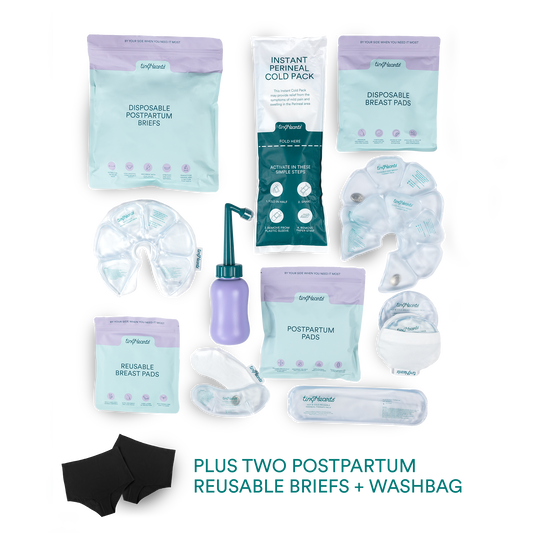- Slow introduction of foods is not necessary
- First foods can be introduced in any order
- Introduce at any rate that suits your child
- No need to avoid or delay introducing egg, peanut butter, wheat or fish, as previously recommended to prevent allergy or eczema.Even for babies whose siblings have allergies
- The ASCIA infant feeding guidelines say that all babies should be given allergenic solid foods including peanut butter, cooked egg, dairy and wheat products in the first year of life
- Introducing allergenic solid foods can actually protect your child from developing an allergy
At Baby Bistro, we believe that starting your baby on solids should be a fun experience for you and your baby. Remember that all babies are different, will have different tastes, enjoy different textures, some will need plenty of time to get used to solids and others will take to it straight away.
The initial introductory period between 6-8 months should be exploratory and a time for babies to get used to solids with their main food source still being breastmilk or infant formula (babies still require breastmilk or formula until at least 12 months of age). At this stage babies are unlikely to be eating 3 solid meals a day, or finish a bowl of food. Remember this first stage is about having fun, letting your baby explore a new sensation and learn a skill.
Between the 8-12 month mark, now that your baby is more experienced with solids, it is a great time to start introducing a mealtime routine, such as breakfast, lunch and dinner. This is a totally new experience for them (and you) and by introducing solids in a relaxed and fun way it will assist with the ongoing relationship your baby has with food and mealtimes. We hope this article is helpful and makes it easier for you to embark on this exciting time in yours and your baby’s life.

Some Important Information
Most babies around the age of six months, are ready for foods, new textures and modes of feeding (1). Some indicators that your baby is ready are:
- Sitting by themselves, or with minimal support, and good head control – this is important to reduce the risk of choking
- Watch on in interest when those around them eat, or even reaching for your food
- Some babies may begin to need/drink more milk at feed times
Choosing healthy food for your baby is essential to provide the nutrition they need for optimal health, growth, development and learning, and establishing these healthy eating habits early is thought to assist in the choice of a broader range of foods later in life.
The texture of foods should be suitable to your baby‘s stage of development, progressing from pureed, to lumpy, to normal textures during 6-12 months. Delaying the introduction of solid foods beyond this age may actually increase the risk of developing food allergies (2).
It is important to always supervise babies and young children when they are eating. Having your baby sitting upright in a high chair not only helps to prevent choking, but also encourages social interaction and helps your baby to learn about eating and mealtimes. It can also be fun to talk with your baby about what they are eating including the colour, the texture and flavours.
Ideal First Foods
First foods, should be blended into a silky, smooth puree, making it perfect for little mouths new to solid foods. Some ideal first pureed foods are vegetables such as Baby Bistro’s broccoli, carrot or cauliflower. You can also try apple or pear, meat, poultry, fish, cooked tofu or legumes. Dairy products such as full fat yoghurt and cheese can then be added. Even though foods can be introduced in any order, it is preferable to introduce the sweeter varieties later, for example, start with vegetables such as broccoli or sweet potato before introducing pear or apple.
Chunky, Mushy, Messy Stage
At around 7-8 months of age you can try introducing your baby to varying textures of foods, and in fact introducing lumpy textured foods at this young age can decrease feeding difficulties in the toddler years (3). Chewing also helps develop muscles for eating and speech so it is really important for little ones to start practicing at this early stage. You can offer textures from mashed to chunky, chopped and minced foods and includes items such as bread, pasta, rice, pure nut butters (no salt or sugar), and full fat dairy such as cheese and yoghurt.

Finger Food
From around 8 months of age, most baby’s have progressed from sucking to chewing and biting, and can manage finger food as their hand control improves. As soon as they are able to grasp objects, you could try encouraging your baby to feed themselves by offering soft finger foods such as chunks of banana or slices of avocado.
8-12 Months and Beyond
Once you reach this phase, your baby will have enjoyed testing out a range of foods with varying flavours and textures. At this point, your baby will most likely require greater amounts of food and we believe it is a great time to start setting up mealtime routines for breakfast, lunch and dinner.
Baby Bistro Tip: Salt should not be added to baby food as their kidneys are immature and unable to excrete excess salt. Infants given salty or very sweet foods may also acquire a taste for them, resulting in poor food choices later in life (4).

Food Allergies
For more information on Food Allergies when introducing foods to your children, please see the Tiny Hearts guest blog on Baby Bistro’s website here.
It is important to remember that if your family has a history of food allergy, your baby has a food allergy, you are worried about reactions to foods, or if food choices are restricted for medical reasons, seek advice from your GP, child and maternal family health nurse, paediatrician or dietician.
At Baby Bistro we understand that as busy parents you may not always have time to make home cooked, fresh food for your little ones, but you still want to provide them with the best. That’s why we have created our range of healthy, organic, home-style meal options as a convenient and easy backup without having to sacrifice health and nutrition. We have four ranges from Baby Starters, Baby Mains, Toddler Mains and our new Big Eats range for kids 12 months plus - the range has also been popular with adults too! You can order our entire range online at www.babybistro.com.au and it is available in the freezer aisle at various stockists across Victoria.
Written by Rebecca Screen who, as a naturopath, health coach and That Sugar Film Ambassador, brings a wealth of knowledge and experience about nutrition and health to the Baby Bistro team.
References:
- The Royal Children’s Hospital Melbourne
- Murdoch Children’s Research Institute
- Australian Government National Health and Medical Research Council
- raisingchildren.net.au
- (1) World Health Organization. Global strategy for infant and young child feeding. Geneva:WHO, 2003
- (2) National health and medical research council – Rogers B. Feeding in infancy and later ability and attainment: a longitudinal study. Dev Med Child Neurol 1978; 20:421-6
- (3) Northdtone K, Emmett P, Nethersole F. The effect of age of introduction to lumpy solids on foods eaten and reported feeding difficulties at 6 and 15 months. J Hum Nutr Diet 2001;14(1):43-54
- (4) Mennella J, Beauchamp G. Early flavour experiences: research update (Reprinted from Paediatric Basics, vol 82). Nutrition Reviews 1998;56(7):205-11
Further Reading:
- Koplin JJ, Osborne NJ, Wake M, Martin PE, Gurrin LC, Robinson MN et al. Can early introduction of egg prevent egg allergy in infants? A population-based study. J Allergy Clin Immunol 2010;126(4):807-13
- Jennings S, Prescott SL. Early dietary exposures and feeding practices: role in pathogenesis and prevention of allergic disease? Postgraduate Medical Journal 2010;86(1012):94-9
AAP = American Academy of Pediatrics
EFSA= European Food Safety Authority
ASCIA = The Australasian Society of Clinical Immunology and Allergy







